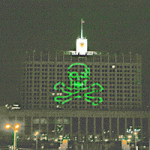The Art of Dissidence
 Index on Censorship has a detailed and penetrating article on the Voina collective, the bright stars of Russian art activism. In the piece, which is well worth reading in its entirety for an insight into the group’s activities, Nick Sturdee identifies some of their lesser-known but no less powerful actions. Sturdee, who is currently making a film about the collective, goes on to name a handful of other artists who are also using their work as a tool of political criticism in a society which is increasingly intolerant of opposition:
Index on Censorship has a detailed and penetrating article on the Voina collective, the bright stars of Russian art activism. In the piece, which is well worth reading in its entirety for an insight into the group’s activities, Nick Sturdee identifies some of their lesser-known but no less powerful actions. Sturdee, who is currently making a film about the collective, goes on to name a handful of other artists who are also using their work as a tool of political criticism in a society which is increasingly intolerant of opposition:
While Voina has been the most successful — and most controversial — exponent of art “instead of politics”, the group is not alone. Novosibirsk artist Artem Loskutov has for two years organised absurdist street demonstrations called “Monstrations” , where hundreds of participants march with apparently meaningless signs (such as “Yyt”, “Chunga-Changa”, “Why are you so nervous?” and “Tanya, don’t cry!”). The effect is a carnivalesque subversion of politics and plays on the lack of dialogue in the political scene in Russia. Ilya Falkovskii, Aleksei Katalkin and Boris Spiridonov and their music and animation group PG Dreli post playfully menacing videos on the internet — such as young men firing a bazooka at Vladimir Putin’s motorcade — and photographs such as “Somalia is Here” (with armed militants firing on government buildings in Moscow). Grigory Yushchenko exhibited a series of traditional “lubok” pictures of drunken policemen in a Siberian art gallery, while the group “Sinie Nosy” (“Blue Noses”) produces satirical prints, the most famous of which — “The Era of Mercy” — depicts two Russian policeman kissing tenderly in a snow-covered birch forest. Then there are activists and bloggers whose activity is categorised as politics but whose style and self-representation are not far from those of many of the artists listed — and certainly not far from Innovation laureates Voina. Underground political activity and the internet are saturated with such content. The “revolutionary socialist” DSPA (Petr Alekseev Resistance Movement) — are friends of Voina and have a history of unfurling banners satirising and mocking the St Petersburg and national leadership, often with deliberately childlike word play. The National Bolshevik Party, a kind of postmodern revolutionary party created and led by the writer Eduard Limonov, has aligned and realigned itself with various strands of nationalist and anarchist thought, and is adept at being at the forefront of street protest. The musician Savva Terentyev, who wrote in his much-quoted phrase in his Live Journal blog that one or preferably two policemen should be burned in the central square every day, has become a well-known counter-culture figure. Flash mobs abound, and periodically mass protest groups emerge and form around a single issue — such as hundreds of car owners and YouTube users in the “blue-bucket” campaigns against bureaucrats abusing privilege to use emergency lanes on Moscow’s congested streets.
Read the whole article here.











